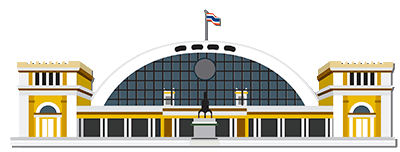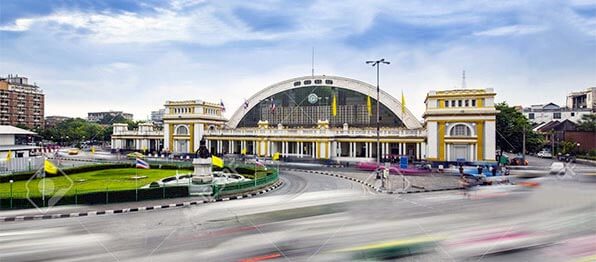 Thai Rail Network
Thai Rail Network
Trains are a good alternative to buses to get around Thailand, although the bus network is more widespread. Trains are slower than buses but cheaper and safer, and they offer more chance of sleeping during overnight trips, in case you choose a class with sleeping bunks. Thailand has a good metre-gauge rail system, one of the best in the world apart the western and Japanese ones. The State Railway of Thailand, SRT, is the state-owned rail operator in the Kingdom. The network includes about 4000 km of lines along the whole country and it serves around 45 million passengers per year. It consists of four main lines and a few branch lines. The Northern Line connects Bangkok with Chiang Mai via Ayutthaya, Lop Buri, Phitsanulok and Nakhon Lampang. The Northeastern Line splits into two just beyond Ayutthaya. The lower branch runs eastwards to Ubon Ratchathani, via Nakhon Ratchasima and Surin. The northerly branch connects the capital with Nong Khai, the border town with Laos. This branch has a short extension over the Mekong River, on which runs the shuttle train between Nong Khai and Vientiane. The Eastern Line also has two branches; one connects Bangkok with Aranyaprathet, the border town with Cambodia, the other connects Bangkok with Pattaya. The Southern Line connects Bangkok with Hat Yai, via Hua Hin, Chumphon and Surat Thani, where it splits into two branches. The eastern branch runs down the peninsula until Sungai Kolok, on the eastern Thai-Malaysian border; the western branch continues down the peninsula until Padang Besar, the western border town, and then to Butterworth, in Malaysia. This branch of the Thai railway is connected to KTMB the Malaysian railway network. With a change of train in Butterworth, or even in Padang Besar, it is possible to reach Kuala Lumpur and then Singapore. At Nakhon Pathom, a branch of Southern Line veers in the direction of Kanchanaburi and then, after crossing the Bridge on the River Kwai, ends at Nam Tok, this stretch is all that remains of the infamous Death Railway. SRT official Website: www.railway.co.th
Thai trains
Thai trains are often old; anyway, first and second-class are quite comfortable. Trains are slow, but if you travel during the day, it is good opportunity to take landscape pictures. Thailand's trains have three classes. The first-class, available on long-distance trains, which provides private cabins with two seats and air conditioning, the seats inside are transformed into two beds. The second-class does not provide private cabins, it has wagons with bunk beds separated by curtains or seating with comfortable padded seats, both with or without air conditioning. The third-class carriages are often crowded and populated by street vendors. They are relatively comfortable, as well as very economical. There are several different types of train. The Ordinary Train, ORD, is the slowest; it has only third-class seats and is generally available only on short and medium distances. The Diesel Railcar, DRC, provides a service similar to ORD, only slightly faster. The Rapid Train, RAP, has a misleading name, just little faster than previous; it has second and third class and is used on long distances. The Express Train, EXP, and Special Express, SP EXP, are a little faster, have all three classes and are used on long distances, as well as the fastest Special Express Diesel Railcars, EXP DRC, which has only the second class. Nearly all long-distance trains have dining cars, and rail staff will bring meals to your seat.
Rates & booking
Rates depend on the class of seats, whether with or without air-con, and on the speed of the trains, as there are surcharges on express trains. The third class seats are much cheaper than buses, for example: the journey Bangkok–Chiang Mai costs 271 THB. A second-class seat, on the usual journey, costs 431 THB with fan, 641 THB with air-con; a second-class upper berth with fan costs 531 THB and 581 THB for lower berth, while with air-con the prices are 821 and 751 THB. A first-class upper berth in private cabin costs 1,253 THB and 1,453 for lower berth, it means a two-person air-con sleeping compartment complete with washbasin. To find availability in first and second-class booking in advance is highly recommended, a few days for the seats and as soon as possible for bunks and sleeping cabin. The SRT has tried to make Advance Booking as easy as possible; in fact, you can book tickets up to 60 days ahead at any railway stations and up to 30 days ahead online. It has also launched the Online Booking in February 2009, but this became temporarily unavailable in September 2010 and then decided to discontinue definitively the service in January 2013.
Railway Stations
The station is within walking distance of Chinatown, near the bank of Chao Phraya River. It is easily reached by taxi, tuk-tuk or subway...
All trains of SRT that leave northbound from Hua Lamphong Station in Bangkok pass through the station at Don Mueang Airport...
Amazing Railway Lines
The bridge over River Kwai and Death Railway are the major attractions in Kanchanaburi.....
Mae Klong Railway Market is located in a quiet town 100 km south of Bangkok, on the road...
A truly unique way to cross Thailand, Malaysia and Singapore by train is to travel with.....










